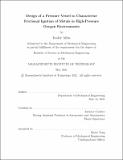Design of a Pressure Vessel to Characterize Frictional Ignition of Metals in High-Pressure Oxygen Environments
Author(s)
Allen, Kailey
DownloadThesis PDF (4.070Mb)
Advisor
Cordero, Zachary
Terms of use
Metadata
Show full item recordAbstract
The components of rocket engines are exposed to environments that are oxygen-rich, reach high-pressures, and cause the abrasion of rotating parts. Studies have shown that these conditions cause nearly all metals to develop an oxide tribolayer, which initially lubricates the rubbing surface, but later exposes fresh metal to be ignited once it wears away [1]. Frictional ignition has caused multiple catastrophic vehicle failures, and the mechanisms that drive it are poorly understood [2, 3]. Understanding the factors behind wear and ignition of different metals in rocket engines is essential to making more informed design decisions that prevent failures. One way to characterize the behavior of metals is to perform experiments in a testing rig that simulates the conditions of rocket engines. The goal of this study is to create a pressure vessel for such a rig. After designing and analyzing two vessels, it was determined the final design will be cylindrical and allow the use of a torsional sonotrode to rapidly wear down samples, which will be imaged and measured to determine the relative flammability of different metals.
Date issued
2021-06Department
Massachusetts Institute of Technology. Department of Mechanical EngineeringPublisher
Massachusetts Institute of Technology